Jamie Jean Schneider DommDigital Strategist, Social Media + Big Data, North American Division Even the best writers must adapt their style for online writing. While learning the rules and best practices of academic or journalistic writing creates a solid educational foundation, online writing requires a completely different style and approach to get the point across as quickly, clearly, and effectively as possible. Copy that’s written for an online audience may seem too simple, even formulaic, since this type of writing is more casual and straight-forward. However, years of research proves its effectiveness in the digital space. Bottom line: the goal of writing online content is to connect with the reader, not elevate the author. It’s about meeting the reader where they are and giving them the information they seek, all while “desiring their good” (sound familiar? MH, 143). In other words, it’s not about us; it’s about those we are seeking to serve. As you read through this section, remember: Good communication is when you communicate in a way your audience understands. Writing for an online audience is not the time to communicate in a way that highlights the author’s vocabulary or intelligence. Our goal is always to uplift Christ first, and this means putting self aside in all aspects of ministry and prioritizing the needs of those we serve. We should endeavor to meet people where they are, on the platforms where they spend their time, in the way they prefer to consume content, and with language they can connect with. 9 Principles for Writing Strong Online Content1) Remember the four primary purposes for online writing (content evangelism). Effective online writing has at least one of the following primary goals. This is especially true for content marketing/evangelism, which requires consistent production and distribution of quality content to attract, engage, and nurture an audience. The four purposes are:
2) Write like you’re talking to a friend: conversationally. The best online writing is conversational, yet straightforward. Think about how you’d explain something new to someone you know, and write just like you would speak (minus tics, fillers, and mannerisms). You wouldn’t waste time on flowery, poetic words, and you’d try to relate your concept to your friend’s life. You’d be up front about why this subject might be of interest and how it could benefit them in particular. The number one reason people share content online is because they feel it will improve the lives of others. As digital evangelists, our goal should be to create sharable content that benefits the lives of others. The Church should be a leader in creating content of this kind. In addition, you shouldn’t spend a lot of time on technical details or bells and whistles, unless you know your friend is interested in that. Instead, you’d focus on how this topic will affect them personally. The great part of writing targeted online content is that, as long as you’re clear about your topic, your demographic will already be interested in what you're writing about! After all, they have searched for topics mentioned in your articles or posts and decided your page is worth visiting. Since your readers used a search engine, social media post, email message, or other website to get to your content, you don’t have to worry about convincing them that the topic itself is interesting. Your job is to convince them that you have information about their chosen topic that is better, deeper, more interesting, or more applicable than other sources. Ask yourself: what will the reader get from my content that they can’t get from someone else? Getting to your point early—in the headline, subtitle, and opening paragraph—is key. Think about that conversation with a friend. Have you ever been in a conversation where your counterpart struggled to get to the point? They’re over-explaining the peripheral details, giving too many examples or metaphors, or trying to come up with language that softens the blow of an edgy idea or uncomfortable topic instead of outright saying what they mean. You’d quickly realize how much time is being wasted and you’ll wish you had asked someone else to begin with! That’s how an online reader feels when the content doesn’t get to the point. They’ll click “back” and go to the next link in the search results. Tips for writing conversationally:
3) Evoke an emotional response. Reaching your target audiences in a deep and emotionally compelling way is key to effective communication, powerful evangelism (marketing), and creating authentic connections. In the case of mission work and cause-based initiatives, strategic placement of key words can help facilitate deeper thought and increase impact on the reader, driving them to action. The best headlines and teaser lines receive an “Emotional Marketing Value” (EMV) score of over 40. In other words, the best online writing incorporates high impact words in a way that is quickly understood by the reader and evokes an emotional response. We are after all, highly emotional beings, who often make decisions based on what directly affects us. In a world of competing priorities and overwhelming need, this can be a useful tool to help your message stand out among the digital clutter. Afterall, your message must be read in order to have impact. The emotional richness of copy is evaluated based on three categories: Gorgeous2God example: Life is tough but you're not alone. Join our community of young Christian women tackling real issues from a godly perspective.
Remember to also boldly make your claim up front, then use the rest of your content to back it up. If the point you’re making is a bit jarring, that’s not necessarily a bad thing. Plus, by getting to the point early, you tell your audience why they should prioritize your content over someone else’s. People are busy; state the value up front and then deliver on that promise. Consider the idea of inspiring people by agitating emotional states: People don’t do things because they’re comfortable. People don’t do things because they’re bored. People do things because they’re excited, outraged, empowered, inspired, shocked... Example: Feeling depressed? You're not alone. 10 ways a relationship with Jesus will dramatically improve your life.
4) Move your reader to action. The heart of copywriting is persuading readers to take an action. Sometimes, when we think of marketing copy, we think about those spammy e-mail subject lines that over-promise and over-guarantee, or we cringe at clickbait headlines for videos or blog posts. Well, if sales copy puts a bad taste in your mouth, keep in mind that you’re thinking of bad sales copy. When copywriting is done conversationally, with the reader’s feelings, interests, and beliefs/core values in mind, it can be incredibly effective. Remember, people are drawn to authenticity and honesty. Church messaging should always demonstrate the highest level of integrity. Define the problem Throughout a piece of writing, a reader is moved to action by introducing a problem that the reader needs to solve. They want something, they’re confused about something, or they don’t know the next step in a process. You outline the problem, describe the implications of this problem, and then give them the solution—your resource, your solution, your method, your information, etc. Benefits vs. features When describing how great your resources/belief/method/service/information is, don’t just list its features—describe the benefits it will provide to your reader, and why those benefits are in their best interest. People want to know why before they take the time to understand the how. For example: “Buy our hibiscus tea!” Why? “Our blend has more antioxidants.” Ok...what does that mean? “Antioxidants decrease free radicals in your bloodstream.” Ok...what does that mean? “Antioxidants keep the cells in your body from breaking down!” Ok...but what does that mean for me? “Well, this tea has been shown to help lower high blood pressure, according to the American Heart Association’s 2008 study.” That sounds pretty important. How does it taste? “Great! Especially with honey!” Well, all right then—why didn’t you say so? When we’re personally invested in the subject of our writing, we can get lost in the details. Remember that the readers aren’t there yet. They need to see a connection between what they’re searching for and what you have to offer. For example: “You’ve been diagnosed with high blood pressure, and it can be tough to give up some of the foods and beverages you’ve enjoyed for years—like coffee, black tea, and soda.” You speak the truth. It’s like you’ve been there, man! “But what if there was a soothing hot drink that could be just as tasty, AND help lower your blood pressure at the same time?” Is there? That would be so helpful right now! Tell me more! Superperfect Tea Company offers premium hibiscus tea. And, according to a 2008 study by the American Heart Association, it lowers blood pressure in pre-hypertensive and mildly hypertensive adults. I could use that! How does it taste? This ruby-red herbal tea has a slight tart flavor reminiscent of cranberries. Add a little honey, and it delivers a light, tangy “bite” that can pick you up in the afternoon or calm you down in the evening. Mmm. Can I try some? Notice how the problem was outlined in the introduction, with the primary benefits immediately following. Meet the readers where they are, then tell how your amazing product is just what they need...and why. Now, if we frame this in the context of ministry, your product is your message, which may be hope, wholeness, health, lifestyle, truth that answers their deepest longing, answers to their physical/spiritual needs, sound advice, and more. Calls-to-action (CTA) Once you’ve “sold” the product by connecting with your readers’ needs, it’s time to tell them to buy it! In ministry, this may mean subscribing to your newsletter, registering for a seminar or health clinic, coming to an event, or joining a small group dedicated to a particular topic. Don’t leave them hanging. They want to take action, and the more clear and straightforward the call, the more likely they are to follow through. You may have already imagined a call-to-action following the last line of the hibiscus tea conversation: “Yes! Get 20% off your first box of tea when you order now!” or “Yes—get a free sample sent to you now!” Copywriting isn’t complete without a call-to-action. It doesn’t have to be overly clever or cute; it just needs to make sense. Here are the most common calls to action that appear in online marketing:
5) Tell stories. To share stories is human and approachable. There is an old Jewish parable of “Truth & Story” where naked Truth traveled from village to village trying to find acceptance and love. In each village, Truth was mocked, ridiculed and ultimately chased away. Naked Truth was hated by all she encountered. From afar, Truth saw Story, dressed in beautiful robes, enter the village that had just rejected her. The people loved Story and praised her beauty, quickly embracing her. Story later found Truth crying far outside the village and asked what was wrong. Truth revealed her desire to be accepted like Story and shared the pain of her experiences. Taking pity upon Truth, Story shared some of her beautiful robes with her so that she was no longer naked. From then on, Truth and Story always traveled together, and everywhere they went, the people rejoiced and welcomed them. Storytelling is a powerful means of communication online because: Stories never tell us what to think, they give us something to think about. Stories don’t tell us what to feel, they cause us to feel. Effective writing is both a science and an art. Yes, wordsmithing is a creative process, but copywriting is a science backed by research. A great way to add creativity to the elements of formulaic copywriting is through storytelling. People can’t help but be interested in stories. As humans, we want to know how things turn out! For generations, storytelling has been the way people learn their history and connect. The Bible itself can be viewed as a collection of stories that draw people to God, teach us difficult truths, and connect us through a shared set of beliefs. To “win” souls, we, as a Church, must connect with a person’s experiences through stories. Not only is storytelling a powerful means of communication, but a vital tool for sharing a message of hope. Jesus told parables because truths revealed through stories are an effective way to reach people with thought-provoking topics that are easy to remember. We, like Jesus, should become expert storytellers. Storytelling connects people and gets them engaged and interested in each other. The reason why people love watching movies and reading books is because we love to be immersed in stories. Social media is people connecting with people to create a collective human story. Our job is to frame that story within the context of our faith. We can provide answers and connection online users are looking for, if we’re strategic and intentional with what we write and the content we create. Stories can be in the form of case studies, testimonials, video retellings, or simple anecdotes that describe how a person—just like the reader—struggled with a specific problem. Maybe they tried several things until finally discovering what really worked. Where can you find real stories? As a ministry, you might already have them. Think of the people you’ve served. Think of the events you’ve held. Think of the testimonies your constituents have shared with you. How does their journey reflect a common need or experience within your target audience? Going deeper, what analogies or metaphors can you draw from what you do? Can it be related to common daily life concerns? How does your ministry offer practical solutions? Check out this article on finding marketing stories in everyday life. Write down a story that you would share with your audience that could come across as relatable and relevant to their core values or needs. 6) Know the difference between content writing and copywriting. While these terms are sometimes used interchangeably, they are different. Copywriting refers to the science, the persuasive writing formulas, the headlines, and the calls-to-action. Content writing could be considered the filler content that fleshes out the formulas for content marketing purposes: the stories, the details, the background information, the educational steps, or other valuable pieces of information you’re offering your reader. In many ways these two elements of writing overlap and work together, and both occupy vital roles in the digital evangelism process. There are increasingly specific definitions of these two terms across the internet, but the bottom line is that these writing styles and formulas work together to provide value to the reader, persuading them to stick around and, eventually, take action. 7) Know how to use evergreen vs. time-sensitive content. There are two primary categories to consider when crafting your overall website content: time-sensitive content and evergreen content. While, indeed, simple concepts, when it comes to SEO, content marketing, and user experience, there are strategies to consider in the implementation of these two content types. Announcements, breaking news, special offers or promotions, seasonal content, and events are time sensitive by nature. It’s good to have some time-sensitive information on your website and social media—if you consistently keep it up to date. It demonstrates to site visitors that your organization is active and aware. It is more frustrating to go to a website/profile with out-of-date information than to go to a website/profile with no time-sensitive information at all. If an event from a couple months ago is still headlining, how can the visitor trust that the rest of your information is current? Evergreen content, however, refers to elements on your page without an expiration date. It’s static content that doesn’t change (much) over time. It doesn’t need to. It’s written to stay relevant and useful to your audience regardless of when they read it. For general website and social media copy, this evergreen content includes:
Effective messaging, whether you are publishing content regularly on a blog, posting on social media, or sending emails, requires new, helpful content to stay fresh and up to date. However, that doesn’t mean that each piece of content must be time-sensitive. You can cultivate them to be evergreen as well as timely. To keep new content evergreen, the key is to stick with topics rather than dates. While some of your social media or email content may contain time-sensitive information, they can link back to an evergreen blog post that covers a related topic thoroughly and that you periodically update as information changes. To help your posts, pages, and articles stay evergreen in SERPs (search engine results pages), try removing the publication date from your post (unless it’s necessary). For the many seekers that check the date on webpages before clicking on them in search results, removing the date altogether can help present your content as timeless. If you’re a church posting each week’s sermons as videos or podcasts, the first priority to keep these elements evergreen is to title each one topically rather than with the date of the service (i.e., “Teaching Your Kids to Pray” vs. “Sermon 4-25-17 on Prayer”). Note that you can still show the date in the subtitle or descriptions for members that search by date, but the title should be presented like a headline. The topics covered in evergreen content must be “enduring topics,” discussing common experiences of the human condition (job interview best practices, dealing with grief and loss), timeless skills (how to pray, how to change a tire) or opinion/discussion pieces (which translation of the Bible is best?, is it better to exercise in the morning or evening?). Additional ideas for effective evergreen content with examples:
8) Find ways of repurposing content to diversify your presence across multiple platforms and channels. We’ve covered the different types of content that can be created to reach a variety of content consumers, as well as what makes content “evergreen,” or relevant past its publication date. These principles can come in handy in the beginning stages of your SEO and content evangelism strategy and when it comes to repurposing content. Instead of creating a different piece of content for each platform you publish to, you can repurpose one core content piece to work across a variety of channels. Here's an example of how you can make one blog post explode into ten different pieces of shareable content: You, a nationally-renowned sandwich artist, wrote a winning post for your sandwich-making fans.
Repurposing content can allow a specific topic to be discussed online longer by spreading out the publication of each repurposed item. Furthermore, the same topic repurposed into ten different forms (example above) can create a bigger splash as it makes its online debut. This strategy creates more options for Google to index, increasing your chances of showing up prominently in search results, and it also allows your content to show up in the search engine results for various social media platforms as well. 9) Consider SEO-specific elements of online writing (Titles, Tags, and Descriptions). While seemingly small, these more technical areas of online writing can make a big difference in how Google views your site and in convincing people to click on your webpages and content in search results. Title Tags Sometimes called the “SEO Title,” this is the title that appears in search engines and what is displayed at the top of a browser tab when a reader opens your page. Be clear and straightforward about what your page content covers. If your page is about Bible studies, make sure those two words are in the first three words of the title. According to the SEO experts at Backlinko.com, Google “puts more weight” on words found at the beginning of title tags. For example, say you want to rank for the keyword/phrase “couples Bible study” and you thought of two SEO Title choices:
Google would rank the first one over the second one because it would deem it more relevant and topic-centric. The second one is not a bad headline (save it for your H1!) but Google favors SEO Titles that are more direct. Editing your page title in HTML code looks like this: <head> <title>THIS IS YOUR PAGE TITLE</title> </head> Otherwise, most content management platforms have a designated space to add or change a webpage’s title. NOTE: If you already have significant traffic coming to your page with your current page title, even if it’s not optimized for the intended keyword, you might want to check your analytics before changing it. If visitors that come in through that page are staying on your site and clicking, downloading, buying, etc., you may want to consider keeping it the same, because you don’t want to lose that current traffic. If you notice that people are coming in through this page but then leaving the site, a title change could be highly beneficial. Meta Tags or Meta Descriptions This is the approximately 200-character teaser-like blurb that appears directly below the SEO title in search results. Often, this is what convinces the reader that your content is valuable. Your meta description can be as long as you want, but Google will cut it off anywhere between 250-300 characters, depending on the amount of pixels those characters occupy. While the recommendation used to be 160 characters, Google raised the number of permitted characters as of December 2017. It was changed again in the spring of 2018, then later adjusted to the current recommendation of 200 characters. In light of this apparent state of flux, aim to keep meta tags as short as possible while including the necessary information. Using keywords in the meta description can give a small boost in search engine optimization, but the primary purpose of meta descriptions is to get the googler to click on your site. This is where you expand on your page title, pitching why your website has what they are looking for. For example, if you’re selling vegan, gluten-free granola bars, you might want your meta description to say something like: VEGLUFRE—A fast, tasty, healthy breakfast option! Packed with protein, fiber, vitamins, and minerals, our vegan, gluten-free granola bars make a great meal or snack. 5 flavors! Order in bulk & save! Make sure to connect the benefits of your product, service, or idea/cause with the needs and interests of those you hope will click on your link. List a key selling point or two, then describe what they’ll find on the page and why it matters to them. Most content management platforms will have an area for you to enter the meta description for each page, or you can install a WordPress plugin like Yoast that allows you to edit the entire meta description. To enter a meta description straight into the HTML, the <meta> element will always go inside the <head> element. It will look similar to: <head> <meta name=”description” content=”THIS IS YOUR META DESCRIPTION”/> </head> NOTE: Every page should have its own unique meta description. Google notices if multiple pages have the same meta description, and many SEO auditing software programs will note redundant meta descriptions as an SEO error. H1 Tags/Headers/Headings This element of your page doesn’t typically show up in search engine results, but it is the first thing googlers will see after clicking on the page. To make sure they stay there, devote attention to creating effective headlines. Make sure to specify what they’ll find there and why they will want to continue reading. Include some keywords in your headers, pinpoint a benefit your content offers, and give brief hints at what the content covers. For example: “Can’t decide which Bible translation to use? Learn the history of the differences between Bible translations” or “7 Ways to Simplify Complex Recipes for Easy, Healthy Dinners” In the example below, “Coping with Depression” is the H1 tag, demonstrating how a keyword should used in the first three words. The subtitle, “Tips for Overcoming Depression…” has specific subtitle formatting, and the subhead “How do you deal with depression” lower on the page is formatted with the H2 tag. You designate your text as H1 by adding the <h1> tag to the HTML code, or by selecting “Headline” or “H1” or a similar option from your content management platform in the “Style” section. This will typically make the text larger and bolded, or possibly a different font, depending on the theme or template you're using. Each page should have only one H1. For subtitles or subheadings, which are excellent for breaking up long text blocks and making the whole post more skimmable, content managers can use H2 or H3 tags, which will typically appear smaller than H1-designated text. H2 and H3 tags do not have an SEO impact, but can enhance readability. If you can’t get into your content management platform at the moment and want to check how a certain paragraph is designated, right click on the page and select “View Page Source” to view the HTML code. You can also highlight the area, right click, and select “Inspect Element” on Macs. ALT (image) Tags This code-level text makes images searchable by Google. Also known as an “alt attribute” or “alt description,” this HTML tag is applied to an image on your webpage. It doesn’t show up on the page, but googlebots pick it up and use it to determine the topic depth of your page. While Google can determine several aspects about images, Google won’t always “see” the message it’s intended to illustrate or support. To understand the content of the image, Google relies on ALT tags to determine what the picture is and how well it relates to the topic of the page, which impacts your ranking. Additionally, ALT tags provide the image information for:
Don’t make it too long, and make sure not to “keyword stuff” the ALT tag, an old “black-hat” SEO practice that Google will not favor and possibly penalize. For example, for the same image described above on the “sermon tips” page, keyword stuffing might look like: “megaphone sermon tips project voice sermon audience sermon strategies public speaking presentation methods.” Add your ALT text into your content management system, or into the HTML by editing the source code: <img src=”bluemegaphone.jpg” alt=”ALT TEXT HERE”/> For example, in the picture on the previous page about coping with depression, this is how the ALT text appeared in the source code: (Learn more at: https://moz.com/learn/seo/alt-text)
Using these seemingly-minor titles and tags can not only improve your SEO but also your user experience, enticing seekers to click on your site as they comb through search results for relevant information. In summary:
Jamie Jean Schneider DommDigital Strategist, Social Media + Big Data, North American Division When it comes to digital evangelism and discipleship, content is made to inform, to educate, and inspire—for the purpose of attracting and nurturing a loyal audience that connects with your ministry’s message. Ultimately, your goal is to support their growth in their spiritual journey. The currency of content marketing (or in our case, evangelism) is ACT: Authority, Credibility, and Trustworthiness (though we should also add “Empathy” to this list, especially when dealing with spiritual topics and life lessons). Use multiple forms of content to maximize your organization’s ability to get picked up by Google’s search algorithms, as well as to further engage your audience. Keep in mind that certain forms of content will perform better with some audiences than others. By diversifying your content creation strategy, you optimize your reach and increase your impact across a variety of demographics. Here are the four major components that work together in a comprehensive content creation process:
Most Popular Types of Online ContentText The written word is the foundation of any type of content, and, therefore, this is where we must begin. Ideas are usually written down first—whether in the form of notes, scripts, or outlines—before they’re turned into anything else. Even in visual media like video, written content often accompanies and supports the other content types. When you set your content evangelism goals, you’ll want to prioritize quality writing. Keep in mind, however, that good writing in an academic sense is not the same as what’s considered good content writing or copywriting. Writing for digital environments is much more straightforward, casual, conversational, and concise. The most common forms of written content online are:
Video One-third of all online activity is spent watching video. This isn’t surprising. People, as visual creatures, have been naturally drawn to online video and made it one of the most popular ways to consume content for all ages! The increase in mobile device usage has made video more popular as well. With a smaller screen, it’s easier and faster to watch videos than to read text. Video is a great enhancer. Have you noticed that when you click on a news story, the page often has both the written article and the video from the newscast? Not only does it offer two different options for content consumption, it adds a perception of depth and authority to the story. Video content is particularly useful for educational topics, especially “how-to” tutorials and telling stories. Demonstrations, interviews, personal testimonies, time-lapses...some things are just better presented via video. When it comes to YouTube, this platform has created its own niche of search engine optimization. YouTube’s search algorithms rely heavily on keywords, titles, tags, thumbnail images, and microcontent such as video descriptions and channel descriptions. YouTube also measures “watch time,” or how long a viewer watches before clicking away or going back to search results. The more of a video that gets watched, the better that video must be, so YouTube ranks it higher in its search results. Longer videos, especially if frequently watched until the end, get even more of a boost (on other social media platforms, however, it is still generally recommended to keep videos short, around three to five minutes or less). Livestreams With livestreaming, longer videos are always acceptable, regardless of platform. Livestreaming your events, whether on Facebook Live, YouTube, or your website, can widen your audience, further engage your existing audience, and provide an archivable piece of evergreen content that can be repurposed later. This is great for church services, special performances, programs at a school or university, conference sessions, and more. When it comes to SEO, livestreams can have a sizeable effect. Facebook announced that its ranking algorithm favors live videos in its searches. YouTube promotes YouTube Live videos. And even if your organization’s livestreams are hosted off-site, it’s another link to your content that could show up in search results—especially if you’re live often! Webinars (Online training or Bible studies) Taking video up another notch, webinars are exclusive, live, educational presentations. Like its name suggests, it’s a seminar broadcast over the web using tools such as GoToMeeting, Zoom, or Lifesize. Participants are typically invited to webinars and provided with a private link. While the webinar itself would not be indexed by search engines, its power to engage audiences boosts SEO through lead generation and by increasing engagement, trust, and loyalty to your ministry. Webinars can provide a valuable service to your constituents when used to teach useful information (such as tips to improve your marriage), provide background on a popular issue, or facilitate live online discussions. They can also be an effective and convenient way to host digital Bible studies for small groups, allowing face-to-face interaction and relationship building regardless of location. Images While the right pictures can elicit emotion, the right designs can inspire action and highlight strategic details. Careful planning is necessary to make sure the images you’ve chosen indeed emphasize the intended emotion. It must be clear what the picture is portraying, and it should look genuine, as opposed to a cliché corporate stock photo. Used sparingly, stock photography can be a great resource to enhance your ministry’s brand online, and it’s easy to find free stock images at pixabay, pexels, unsplash, and free-images.com. Click here for more free or low-cost stock photography and design resources. For websites, hero images (the large, single images that dominate the top area of a website) continue to be trending. These pictures must be high enough resolution to avoid appearing pixelated (approx. 1600 pixels wide), but low enough resolution to avoid slowing down the site’s load time. For other images that appear on your website, stick to file sizes under 250 kilobytes if possible. Learn more about image best practices for church websites. For each image on your website, blog, or Instagram profile, make sure to apply ALT text, which is indexed by search engines to determine what the picture is about. It also acts as text that can be read by screen readers to tell visually-impaired internet users what pictures are on a page. Infographics When explaining a process in text, an accompanying visual is a must. If, when talking about your topic, you find yourself saying, “Here, let me show you…” or, “Why don’t I just draw this out,” an infographic would probably come in handy. Infographics illustrate each step or point of a process and include short and straightforward text to accompany the imagery—making complicated information easier to understand. Designers and writers must work closely to create an infographic with a clear direction so the eye knows what to read first and where to go next. If you’re short a graphic designer, some free tools like Canva can help you create simple infographics, which add a splash of color to your page, post, or feed while informing and engaging your audience in a creative way. As the below infographic explains, infographics don’t just make your page more pleasant to look at—people actually search for infographics on certain topics. They’re also shared frequently on social media. Think of creative ways to use infographics for ministry, such as mapping out “How to Study the Bible for Beginners.” Podcasts Audio content can include interviews, sermons, vocal essays, monologues, presentations, seminars, and more. Podcasts created from this audio content should be distributed as widely as possible, including on your website, iTunes, and other hosting platforms so users can subscribe. Even if you’re already hosting through a provider such as SoundCloud, Blubrry, Google Drive, or archive.org, it’s worth uploading to other hosting platforms in addition. These simple audio files are a highly shareable piece of content people can listen to while driving, walking, exercising, or cleaning their garage. Having podcasts with your ministry’s name in the title, or hosted by a prominent personality associated with your ministry, can do wonders for brand awareness, which ultimately benefits overall SEO. Interactive content (quizzes, polls, calculators, etc.) This type of content requires audience participation, making their interaction with your ministry far more memorable. You’ve probably seen various character quizzes on Facebook or Twitter. They are highly shareable because, to the audience, it feels like they’re sharing information about themselves, not about the organization that designed the quiz. Interactive content that strives to be helpful or practical might include assessment-type quizzes, calculators, interactive graphs or charts, or polls and surveys. They can also help you with demographic info-gathering for your ministry’s strategic planning. Remember, anything that deepens engagement also boosts SEO! It’s always beneficial to keep people on your website longer. There are many tools that can help you create interactive content, including qzzr, SurveyMonkey, Doodle, Vizia, and more. Courses This type of content can be important for building what Google refers to as an organization’s E-A-T (Expertise, Authority, Trustworthiness). At the same time, courses provide yet another way for your audience to consume your content. If your organization is qualified to teach even a simple skill that has value in your audience’s life (healthy cooking or practical discipleship tips), creating courses can bolster your content marketing and SEO, and become a relevant resource for your site visitors. Not only can this type of content boost your credibility, it can empower your audience for positive change. Beginning Content Strategy Worksheet Filling out this structural worksheet can guide your brainstorming process and help you solidify your content strategy.
Jamie Jean Schneider DommDigital Strategist, Social Media + Big Data, North American Division People value content that helps them make better decisions, answers their questions, and speaks to their core values or interests. Optimizing your content based on search engine queries (what people are searching for) helps you best match your products and resources to the needs and interests of your audience. We previously took a bird’s-eye look at using search results to find relevant content ideas. This section will go into greater depth for those ministries who want to focus more on creating digital content related to their mission and themes. If you’re a digital missionary looking to develop a content creation strategy that will reach beyond a geographical location, bookmark this section. This type of digital evangelism helps expand your messaging to new audiences who are hungry for the resources you can provide. Writer’s block? Find out what people are searching for.Keyword research is the core of what is known as SEO copywriting: writing content based on search engine optimization principles. Search engine optimization is a set of strategies that help organizations reach more of their online target audience. A website’s visibility in search engine results can be elevated by utilizing certain content development techniques. The higher a website ranks when a person googles search terms related to it, the more web traffic it receives. Visit SDAdata.org/SEO to learn more about SEO. Researching keywords removes much of the guesswork when trying to figure out which topics (related to your ministry and mission) make the most sense to explore for your content. It bridges the gap between your hunches, the data, and what information people need or want. This technique uses search query data from Google and other search engines to determine what kind of topics interest people. Creating content focused on commonly searched topics improves the visibility of your content in search results, which helps users find your ministry and increases the impact of your message. Use the following framework as a guide to creating content based on keywords. 1) Define the main topic of your online ministry. For example, you decide you want to start a blog to help Pathfinder leaders. “Pathfinders,” of course, is the topic. But if you title your blog, “Pathfinders,” it’s not specific enough to get search traffic. You have to differentiate from Nissan Pathfinders, Pathfinder International, and the Pathfinder role-playing game. Familiarity with your audience allows you to feature relevant keywords in your titles, headlines, and posts, such as:
While definitely more specific than “Pathfinder” alone, these are also considered broad-match keywords, as they can still have a wide variety of subtopics. They’re certainly good ideas, and posts on these topics can be helpful for your audience. However, they’re harder to rank for in Google search results without further specificity. Let’s say there is a burgeoning trend to create Pathfinder blogs. The broad topic of Pathfinder leadership is now a highly competitive arena. How do you get your blog to stand out? Considering the clear, central purpose of your ministry is a useful exercise for most types of digital content, but you’ll quickly need to distinguish how you’ll be providing something different from the competition. 2) Refine your topic. You have to get more specialized in your focus, so start brainstorming “niche topics”—subtopics within the broad subjects of Pathfinders and meetings and honors and campouts that people might be searching for information about. Some of these might be:
You can also start brainstorming possible blog, social media, and video posts for these subtopics and long-tail keywords:
Start by googling your topics, exploring related words or phrases, and come up with some post ideas. Then ask yourself the following questions:
Maybe you find that the knot-tying honor already has several articles that are well-written and popular. There are lots of positive comments on those posts. Therefore, another topic would be more effective in making your content stand out in search results. However, maybe there’s one particular knot you don’t feel the other writers have explained very well, even though the rest of the post is good. Maybe you’ve found a couple comments on other blogs about how they’d like more information on the hunter’s bend. You might then decide to write a post titled “How to teach the hunter’s bend knot.” This is a simple example of how research and testing can help shape meaningful content creation. 4) Test some more. Here’s where dedicated keyword research tools come in. These tools access data that tells how many people are searching for a certain keyword or keyphrase (search volume), as well as how much content already exists about that keyword (competition). The sweet spot is when you find a word or phrase that has high search volume and low competition. Here’s an example from Google Keyword Planner: Many keyword research tools provide a ratio of search volume and competition. Some tools do require a paid subscription, but some are completely free and offer similar data. These free keyword tools may also show related keywords or phrases, which can be helpful for coming up with good content ideas. Overall, you’ll get a general idea of what people are searching for, enabling you to create content that will connect your ministry with the needs and interests of your audience. Here are some recommended free or low-cost tools for keyword research or keyword ideas:
The tools below differ from true keyword research but can be very helpful for “informed brainstorming.”
5) Create content from keyword research. Once you’ve utilized these tactics and tools, it’s time to use this knowledge for your content planning. Keyword research does more than just tell you which words to use. It tells you which topics are popular, which topics are competitive, and what your best content opportunities may be. This is good news! This means that the organizational methods you learned for writing essays and research papers in school will now pay off in a practical way. For blogs and websites, begin by writing an introduction to a topic (one webpage), then cover the topic (another webpage), then cover related topics (more separate webpages) or background information (another separate webpage or two). It’s essentially writing an outline, and each section of the outline is a webpage. Blogs organized like this score highly in both search engine visibility and user-friendliness. For good examples of this, visit sdadata.org/seo and SDAdata.blog/DDandE. From a visitor’s perspective, this streamlines navigation within a specific topic. But, be careful not to take this concept to the extreme, creating a confusing maze of short pages. Remember that relevant topics and strong topic coverage have a stronger influence on search engine ranking than using individual words or phrases repetitively. The algorithm rewards quality writing and presentation. However, keywords do still matter! Keyword research helps us know what words and phrases people are using. We still want to use those words and phrases as often as we can on a page—naturally. If it sounds hokey to keep repeating a phrase, find another way to say it that means the same thing. Overall, you still want the content to read as naturally and conversationally as possible, as if you were telling this information to a friend. Click here for tips on how to write conversationally.
Here are some tips for thorough topic coverage in natural language that can be adapted for a variety of content types:
Work your way through a topic, creating as much applicable content as possible over multiple digital media posts and platforms. Content organization techniques that may help you include outlines, topic trees, bubble graphs, etc. Using these as your foundation for content creation helps you determine topical goals, objectives, and key takeaways, and makes the whole writing process easier. Jamie Jean Schneider DommDigital Strategist for the North American Division First Impressions Matter to Seekers: Tips for Improving Your Digital Curb Appeal For the first ten years of my career I had the opportunity to develop my digital skillsets in the secular world with the hope that someday these skills could be used to serve God more directly. I am pleased to say that there is a tide-shift happening now in the Seventh-day Adventist Church at multiple levels; we are collectively waking up to the untapped potential of the digital mission field. There is potential for a beautiful marriage between traditional means of evangelism and digital communications. These new technologies are not meant to entirely replace the old methods, but serve to magnify and increase the scale of our efforts in a way that was not thought possible a few decades ago. I spend a lot of time with seasoned evangelists who share wisdom from their experiences in the physical mission field. Many of their proven principles for effective evangelism have direct application in the digital space. To truly move forward with our mission, mentorship and education must go in two directions. Not only can the younger generations teach the older generation about technology and demonstrate how it can be used to advance our cause, but the younger, digitally-focused generations can learn much from the giants of traditional evangelism. Instead of getting frustrated by our different perspectives, we must communicate more effectively with each other to understand our common ground. Like a giant ship set in its regular route, it takes time to turn, and it takes all crew members working together. The methods by which we minister to people and share the gospel are becoming more complex, but human nature, needs, and behavior largely stays the same and is predictable. One “analog” idea that can be translated to the digital space is the idea of “curb appeal.” Long before the internet and 360° video, real-estate agents focused their attention on finding ways to optimize something called “curb appeal” (aka the outward appearance of a property). If someone was interested in buying a house, they most likely would drive by it before calling the agent to request a walk-through. For churches, the behavior of prospective visitors was similar. Pastors and ministry leaders sought to make the outside of their church inviting for potential visitors. This is still important today, but now we have the added need for “digital curb appeal.” The following statistics indicate why:
It’s clear that an organization’s digital presence affects behavior. What do people find when they Google your ministry or find you on social media platforms? Is the content up-to-date? Is new visitor information easy to find? Are there pictures, testimonies, and stories that reflect your church community and appear inviting to others? Is it clear what services and opportunities your church, ministry, or organization provides? According to a LifeWay Research survey, “78% of churches have a website, [but] only 30-40% of churches are using their websites for anything other than an electronic bulletin board! And about 42% hardly keep their websites up to date?!” (Churchleaders.com) The same is true with social media. Are you posting regularly and is all the essential information current? For many, your digital presence will be their first introduction to your ministry and possibly, the faith as a whole. Many people will find your website long before they physically visit a place of worship. A study by Grey Matter Research found that, in the span of one year, “over 17 million American adults who don’t regular attend worship services visited the website of a local church or place of worship.” Your ministry’s website and social media are your biggest digital marketing and branding tools, and it’s where first impressions are made. If your congregation members engage with the corporate Church accounts on social media, it’s likely others are seeing their interactions and could be discouraged OR encouraged to visit your local church based on the kind of content posted. Tell your local story through your website and social media. Reveal a community that others want to join. Your website is a means of communicating, in general terms, everything that your church or ministry offers to a prospective visitor. It's your "curb appeal." Your social media can further demonstrate the type of community they will experience and what sort of spiritual messages they will receive. Importance of Mobile When people search for local businesses using a smartphone, 76% of them visit a related location within one day (Think with Google). As of August 2019, BrightEdge reported 62% of a large sample group conducted their search queries on mobile devices, including tablets, as opposed to computers.
Making your website mobile friendly is more vital than ever, especially since Google prioritizes mobile-friendly content in the search algorithm. I recommend that you regularly conduct an audit of your website and social media to make sure:
Strong brands create connection and take a comprehensive approach to the member experience. Today, that experience often begins online. Your digital presence should make them want to experience your faith/mission in person, motivating them towards action. Amy PrindleThe Center for Online Evangelism is a missionary project devoted to developing online mission stations. Before going full throttle on SEO implementation, it’s important to set expectations and develop a clear understanding of what is needed. To be successful, you must approach SEO strategically and be very intentional about developing a long-term plan to maintain best practices. The first step in SEO care is to keep up to date on the industry. Things change fast—both in the ways people search for and consume content, and in how Google continually seeks to improve its process based on people’s changing behavior. What worked yesterday may not work next month. What’s more, businesses tried to cheat the system and developed many SEO techniques now considered “black hat.” These practices are now heavily frowned upon and will get your site penalized by Google, causing your ranking to plummet which can be challenging and expensive to recover from. Unfortunately, these “black hat” techniques still circulate online, and are often advertised as tips and strategies. It’s important to know what these techniques are to avoid being misled. To safeguard your SEO efforts for your organization, we’ve compiled the top 9 SEO myths that persist today, and what you should do instead.Myth #1: “Get a sweet SEO setup, then relax and enjoy great traffic and engagement.”
SEO work is never done. Just as a business requires ongoing management in order to adapt to market changes, to implement customer feedback, or to update technologies to stay competitive, SEO is an continually evolving process. While setting up a strong SEO foundation is essential, know that investing a lot of time and/or money in this area doesn’t mean you can set it and forget it. As part of your overall SEO grand strategy, include a plan for ongoing SEO that will enable your organization to constantly grow, adapt, measure, learn, and grow some more. Myth #2: “If you do these things, you’ll rank on page 1 in 3-6 months...” Maybe you’ve received one of these ads or phone calls, offering SEO services that guarantee a high ranking––fast. Lofty promises in a short time are a major red flag. No one, not even Google, can guarantee rankings. Also, ranking for what? For which keywords? And which specific page of your website? Beware of vague qualifiers. There are numerous factors involved in search engine ranking. If your organization is in a competitive niche, it can take years of consistent work to rank on page one of Google search results. A solid SEO strategy takes time and patience. SEO is a long game, but it’s worth it because of the potential for eternal good. Knowing that millions of people are actively searching for spiritual answers online, yet not being led to Adventist websites and resources, how can we pass up this incredible opportunity? Like any marketing approach, search engine optimization requires a long-term, flexible strategy that allows for measuring, testing, and adapting over time. Throughout this process, your organization can grow in authority and engagement, maintain relevance, and reach more people every day. If you do receive a solicitation offering vague and unrealistic SEO results, we recommend politely declining. No one from Google will call your organization, and no one can promise specific results for an up-front, flat fee. Remember that the principles of Authority, Credibility and Trustworthiness, coupled with quality content creation and careful monitoring of what your target audience wants, are the true foundational blocks that effective SEO is built upon. Anything that feels like a short-cut should make you hesitate, and anything that sounds too good to be true probably is. Myth #3: “SEO is for the IT department. Let them handle it.” The internet is a media channel, just like radio or TV. However, this medium has surpassed all others in popularity, accessibility, and potential for outreach and mission work. A marketing and ministerial approach is needed to tap into its potential, not necessarily technical knowledge. The foundation for effective online outreach follows the principles of advertising and marketing, but through a ministerial lens. Implementation of inspiring online content requires careful study of what works and doesn’t work and research to understand the needs of the consumer (or to the seeker). For an organization to use the internet for content marketing and outreach, you’ll need someone willing to spearhead corporate digital marketing and content creation with the goal of ministry. An IT department’s goal is to ensure that an organization’s computers and network are functioning efficiently, so the organization can accomplish its mission. Since many church organizations requires employees to wear many hats, it is very possible that the SEO strategy duties could fall to an IT employee, but it requires an additional set of communication and marketing skills than might be needed in traditional IT professional roles. Investment in a dedicated digital marketing strategist is wonderful, but in cases where personnel are called to do double (or triple!) duty, make sure they are empowered, encouraged, and equipped to prioritize SEO strategy. While some organizations do have web developers categorized as IT, SEO also extends well beyond web development. Developers typically take their SEO cues from the content strategists and SEO specialists. While this is a new “department” for our ministries to factor in, the outreach potential makes it necessary as the Church begins to prioritize technology for the gospel. Combining up-to-date marketing strategies and professionals with forward-thinking, media-savvy pastors and evangelists would magnifying our impact exponentially. Myth #4: “Don’t worry about all the technical SEO stuff. Just create good content.” Creating good content is a must, but without intentional promotion or a strong SEO foundation, that good content and the effort it takes to create risks going to waste. SEO specialists and web developers can help you set up analytics tools you’ll need throughout the SEO process. There are slight adjustments to coding or plugins that can make a significant difference to rankings, as well as fix undetected website errors that may be harming Google’s ability to crawl your site. These adjustments do require some technical knowledge to address, but the information and instructions you need can often be a mere Google search away. Additionally, since SEO specialists’ first order of business is to keep up on the industry, if anything changes, they’ll be the first to know about it. It may be months until it gets into the radar of content creators working on their own, and by then, an unanticipated algorithm change could have already done some damage to your ranking. If your organization doesn’t have the budget for an SEO specialist, then it’s even more important to dedicate time to research and self-education in order to stay up to date on your SEO management. SEO works best as a team effort, with multiple points of view working together to craft the best content, supported by the best systems and technical framework. So if you can’t hire a company or specialists, develop a team internally that can focus on different SEO needs. Myth #5: “It’s all about using lots of keywords that get traffic.” Since keyword research is so foundational when developing an SEO strategy, some less-experienced businesses or individuals think they can make shortcuts by using repeated words. As mentioned before, “keyword stuffing” is now considered “black hat” SEO that attempts to cheat the system. Google will not prioritize keyword-stuffed content in its rankings, and your site may even get penalized, causing it to not show up in search results at all. However, including keywords in natural moderation is still a valuable practice. Right now, Google focuses on thorough topic coverage, natural language, and searcher intent. Quality content writers and skilled SEO specialists can easily formulate a content strategy that leaves keyword-stuffing in the ashes. Myth #6: “Our website is awesome. We don’t need to worry about all this extra SEO stuff.” You may have the sleekest, more vibrant website on the market, but if it’s not optimized to be found in searches, who’s going to see it? Unfortunately, this “if you build it, they will come” mentality has greatly limited our ability to get our messages of hope and wholeness in front of the very people seeking it online. Displaying your website on your signage, print materials, and emails is an important part of a comprehensive communications and branding strategy. However, this practice will usually not result in traffic to your website beyond those who are already connected with your organization. In other words, your audience will not grow without an SEO strategy. Being strategic allows you to reach a variety of new target audiences who find your content relevant to their needs, interests, core values, and desires. It can even allow you to grow your volunteer and donor base. Simply put, SEO strategies allow you to share your website and message with the world. As entities of the Church, this is our great commission. Myth #7: “Google changes its algorithms all the time. What’s the point in trying to keep up?” Daily—that’s how often Google fine-tunes its search algorithms, but don’t let that intimidate you. A strong foundation that follows best practices allows your organization to weather these changes and adapt more gradually. Organizations that monitor alternations daily are typically trying to game the system with shortcuts or downright “black hat” SEO techniques. Google uses the daily influx of data it receives to update its methods and deepen its understanding of how people use its search engine. Google’s goal is to give us the search results we want, so that’s where their research and development will consistently focus. Think less foundational, more behavioral. Myth #8: “We just need lots of clicks. Lots of traffic. The rest will fall into place.” Even if thousands of people click on your website from search results, Google pays close attention to how long they stay on your website. If they’re clicking the back button in the first few seconds they land on your page, that tells Google that your content was not relevant for that search query—you were not what they were looking for. The focus is not just getting traffic but getting the right kind of traffic—people who are actually interested in your content already. Those people who are asking the questions your website is answering. This is why content marketing and copywriting principles are integral to the SEO process. It’s less technical than it used to be, because Google found that its users were understandably fed up with clickbait-and-switch SEO approaches. People respond better to high-quality, relevant content instead of sensationalist headlines with keyword-stuffed content. Myth #9: “We just found a company that will do all our SEO and content marketing for super cheap!” Beware. If the deal sounds too good to be true, it probably is. If an SEO agency or freelancer’s selling point is that they’re fast and cheap, you might want to ask them some specific questions before moving forward.
Amy PrindleThe Center for Online Evangelism is a missionary project devoted to developing online mission stations. Even the best writers must adapt their style for online writing. Classically-trained writers may write articles, academic papers, journalistic pieces, or even books. Professors tend to encourage their students to describe things colorfully and thoroughly, to fill the page with rich wording, to emanate cleverness, and demonstrate elevated thinking. While learning the rules and best practices of academic or journalistic writing creates a solid educational foundation, online writing requires a completely different style and approach to get the point across as quickly, clearly, and effectively as possible. At first, writing for an online audience may feel too simple. After all, this type of writing is more casual and straight-forward. However, years of research proves its effectiveness in the digital space. Most forms of online writing follow the fundamental principles of copywriting, which also bridge into the niche area of content writing. We’ll discuss the difference between the two later in this section. The bottom line: The goal of writing online content is to connect with the reader, not elevate the author. It’s about meeting the reader where they are and giving them the information they seek, all while “desiring their good.” (Sound familiar? MH, 143) Here are nine objectives to keep in mind when writing online content: 1) Remember the four primary purposes for online writing (content marketing). Effective online writing should achieve four primary goals. This is especially true for content marketing, which requires a consistent production of content for distribution to attract, engage, and nurture an audience. The four purposes are:
2) Write like you’re talking to a friend. The best online writing is conversational, yet straightforward. Think about how you’d explain something new to someone you know, and write just like you would speak. You wouldn’t waste time on flowery, poetic words, and you’d try to relate your concept to your friend’s life. You’d be up front about why this subject might be of interest and how it could benefit them in particular. The number one reason people share content online is because they feel it will improve the lives of others. As digital evangelists, our goal should be to create sharable content, and the Church should be the leader in creating content that benefits the lives of others. In addition, you shouldn’t spend a lot of time on technical details or bells and whistles, unless you know your friend is interested in that. Instead, you’d focus on how this topic will affect them personally. The great part of writing targeted online content is that, as long as you’re clear about your topic, your demographic will already be interested in what you're writing about! After all, they have searched for content similar to yours and decided your page is worth visiting. Since your readers used a search engine, social media post, email message, or other website to get to your content, you don’t have to worry about convincing them that the topic itself is interesting. You have to convince them that you have information about their chosen topic that is better, deeper, more interesting, or more applicable than other websites. Ask yourself: what will the reader get from my content that they can’t get from someone else? Getting to your point early—in the headline, subtitle, and opening paragraph—is key. Think about that conversation with a friend. Have you ever been in a conversation where your counterpart struggled to get to the point? They’re over-explaining the peripheral details, giving too many examples or metaphors, or trying to come up with language that softens the blow of an edgy idea or uncomfortable topic instead of outright saying what they mean. You’d quickly realize how much time is being wasted and you’ll wish you had asked someone else to begin with! That’s how an online reader feels when the content doesn’t get to the point. They’ll click “back” and go to the next link in search results. 3) Boldly make your claim up front, then use the rest of your content to back it up. If the point you’re making is a bit jarring, that’s not necessarily a bad thing. Remember the idea of inspiring people by agitating emotional states: “People don’t do things because they’re comfortable. People don’t do things because they’re bored. People do things because they’re excited, outraged, empowered, inspired, shocked...” - Christofer Jeschke We’re emotional beings, and the most effective writing tugs at these emotions without going overboard and without being manipulative or sensational. 4) Move your reader to action. The heart of copywriting is persuading readers to take an action. Sometimes, when we think of advertising copy or sales copy, we think about those spammy e-mail subject lines that over-promise and over-guarantee, or we cringe at clickbait headlines for videos or blog posts. Then there are those overzealous sales letters that come in the mail to try to get you to subscribe to magazines or buy retirement plans. Well, if sales copy puts a bad taste in your mouth, keep in mind that you’re thinking of bad sales copy. When copywriting is done conversationally, with the reader’s feelings, interests, and beliefs/core values in mind, it can be incredibly effective. Define the problem Throughout a piece of writing, a reader is moved to action by introducing a problem that the reader needs to solve. They want something, they’re confused about something, or they don’t know the next step in a process. You outline the problem, describe the implications of this problem, and then give them the solution—your product, your method, your information, etc. Benefits vs. features When describing how great your product/method/service/information is, don’t just list its features—describe the benefits it will provide to your reader, and why those benefits are in their best interest. For example: “Buy our hibiscus tea!” Why? “Our blend has more antioxidants.” Ok...what does that mean? “Antioxidants decrease free radicals in your bloodstream.” Ok...what does that mean? “Antioxidants keep the cells in your body from breaking down!” Ok...but what does that mean for me? “Well, this tea has been shown to help lower high blood pressure, according to the American Heart Association’s 2008 study.” That sounds pretty important. How does it taste? “Great! Especially with honey!” Well all right then—why didn’t you say so? When we’re personally invested in the subject of our writing, we can get lost in the details. Remember that the readers aren’t there yet. They need to see a connection between what they’re searching for and what you have to offer. For example: “You’ve been diagnosed with high blood pressure, and it can be tough to give up some of the foods and beverages you’ve enjoyed for years—like coffee, black tea, and soda.” You speak the truth. It’s like you’ve been there, man! “But what if there was a soothing hot drink that could be just as tasty, AND help lower your blood pressure at the same time?” Is there? That would be so helpful right now! Tell me more! Superperfect Tea Company offers hibiscus tea. And, according to a 2008 study by the American Heart Association, it lowers blood pressure in pre-hypertensive and mildly hypertensive adults. I could use that! How does it taste? This ruby-red herbal tea has a slight tart flavor reminiscent of cranberries. Add a little honey, and it delivers a light, tangy “bite” that can pick you up in the afternoon or calm you down in the evening. Mmm. Can I try some? Notice how the problem was outlined in the introduction, and the primary benefits immediately following. Meet the readers where they are, then tell how your amazing product is just what they need...and why. Now if we frame this in the context of ministry, your product is your message, which may be hope, wholeness, health, lifestyle, truth that answers their deepest longing, answers to their physical/spiritual needs, sound advice, and more. Calls-to-action (CTA) Once you’ve “sold” the product by connecting with your readers’ needs, it’s time to tell them to buy it! In the context of ministry, this may mean subscribing to your newsletter, registering for a seminar or health clinic, coming to an event, or joining a small group dedicated to a particular topic. Don’t leave them hanging. They want to take action, and the more clear and straightforward the call, the more likely they are to follow through. You may have already imagined a call-to-action following the last line of the hibiscus tea conversation: “Yes! Get 20% off your first box of tea when you order now!” or “Yes—get your free sample sent to you now!” Copywriting isn’t complete without a call-to-action. It doesn’t have to be overly clever or cute; it just needs to make sense. Here are the most common calls to action that appear online:
5) Tell stories. If these principles of writing for digital environments sound rather formulaic, that’s because they are. Effective writing is both a science and an art. Yes, wordsmithing is a creative process, but copywriting is a science backed by research. These elements of copywriting have been market-tested and are proven to work. However, a great way to add creativity to the elements of this formula is through storytelling. People can’t help but be interested in stories. As humans, we want to know how things turn out! These stories can be in the form of case studies, testimonials, or simple anecdotes that describe how a person—just like the reader—struggled with a specific problem. Maybe they tried several things until finally discovering what really worked. Where can you find real stories? As a ministry, you might already have them. Think of the people you’ve served. Think of the events you’ve held. Think of the testimonies they have shared with you. How does their journey reflect a common need within your audience? Going deeper, what analogies or metaphors can you draw from what you do? Can it be related to everyday life concerns? How does your ministry offer practical solutions? Check out this article on finding marketing stories in everyday life. 6) Know the difference between content writing and copywriting. While these terms are sometimes used interchangeably, they are different. Copywriting refers to the science, the persuasive writing formulas, the headlines, and the calls-to-action. Content writing could be considered the filler content that fleshes out the formulas for content marketing purposes: the stories, the details, the background information, the educational steps, or the valuable pieces of information you’re offering your reader. In many ways these two elements of writing overlap and work together, and both occupy vital roles in the digital marketing process. There are many increasingly specific definitions of these two terms across the internet, but there’s no need to get sidetracked by those at this point. The bottom line is that these styles and formulas work together to provide value to the reader, persuading them to stick around and eventually take action. Learn more about copywriting for SEO:
7) Consider SEO-specific elements of writing (Titles, Tags, and Descriptions). While seemingly small, these areas can make a big difference in how Google views your site and in convincing people to click on your webpages in search results. Title Tags Sometimes called the “SEO Title,” this is the title that appears in search engines and what is displayed at the top of a browser tab when a reader opens your page. Be clear and straightforward about what your page content covers. If your page is about Bible studies, make sure those two words are in the first three words of the title. According to the SEO experts at Backlinko.com, Google “puts more weight” on words found at the beginning of title tags. For example, say you want to rank for the keyword/phrase “couples Bible study” and you thought of two SEO Title choices:
Google would rank the first one over the second one because it would deem it more relevant and topic-centric. The second one is not a bad headline (save it for your H1!) but Google favors SEO Titles that are more direct. Editing your page title in HTML code looks like this: <head> <title>THIS IS YOUR PAGE TITLE</title> </head> Otherwise, most content management platforms have a designated space to add or change a webpage’s title. NOTE: If you already have significant traffic coming to your page with your current page title, even if it’s not optimized for the intended keyword, you might want to check your analytics before changing it. If visitors that come in through that page are staying on your site and clicking, downloading, buying, etc., you may want to consider keeping it the same, because you don’t want to lose that current traffic. If you notice that people are coming in through this page but then leaving the site, a title change could be highly beneficial. Meta Tags or Meta Descriptions This is the approximately 200-character teaser-like blurb that appears directly below the SEO title in search results. Often, this is what convinces the reader that your content is valuable. Your meta description can be as long as you want, but Google will cut it off anywhere between 250-300 characters, depending on the amount of pixels those characters occupy. While the recommendation used to be 160 characters, Google raised the number of permitted characters as of December 2017. It was changed again in the spring of 2018, then later adjusted to the current recommendation of 200 characters. In light of this apparent state of flux, aim to keep meta tags as short as possible while including the necessary information. Using keywords in the meta description can give a small boost in search engine optimization, but the primary purpose of meta descriptions is to get the Googler to click on your site. This is where you expand on your page title, pitching why your website has what the seeker is looking for. For example, if you’re selling vegan, gluten-free granola bars, you might want your meta description to say something like: VEGLUFRE—A fast, tasty, healthy breakfast option! Packed with protein, fiber, vitamins & minerals, our vegan, gluten-free granola bars make a great meal or snack. 5 Flavors! Order in bulk & save! Make sure to connect the benefits of your product, service, or idea/cause with the needs and interests of those you hope will click on your link. List a key selling point or two, then describe what they’ll find on the page and why it matters to them. Most content management platforms will have an area for you to enter the meta description for each page, or you can install a WordPress plugin like Yoast that allows you to edit the entire meta description. To enter a meta description straight into the HTML, the <meta> element will always go inside the <head> element. It will look similar to: <head> <meta name=”description” content=”THIS IS YOUR META DESCRIPTION”/> </head> NOTE: Every page should have its own unique meta description. Google notices if multiple pages have the same meta description, and many SEO auditing software programs will note redundant meta descriptions as an SEO error. H1 Tags / Headers / Headings This element of your page doesn’t typically show up in search engine results, but it is the first thing Googlers will see after clicking on the page. To make sure they stay there, devote attention to creating effective headlines. Make sure to specify what they’ll find there and why they will want to continue reading. Include some keywords in your headers, pinpoint a benefit your content offers, and give brief hints at what the content covers. For example; Can’t decide which Bible translation to use? Learn the history and differences. or 7 Ways to Simplify Complex Recipes for Easy, Healthy Dinners In the example below, “Coping with Depression” is the H1 tag, demonstrating how a keyword should used in the first three words. The subtitle, “Tips for Overcoming Depression…” is designated as H2, as is the subhead “How do you deal with depression” lower on the page. You designate your text as H1 by adding the <h1> tag to the HTML code, or by selecting “Headline” or “H1” or a similar option from your content management platform in the “Style” section. This will typically make the text larger and bolded, or possibly a different font, depending on the theme or template you're using. Each page should have only one H1. For subtitles or subheadings, which are excellent for breaking up long text blocks and making the whole post more skimmable, content managers can use H2 or H3 tags, which will typically appear smaller than H1-designated text. H2 and H3 tags do not have an SEO impact, but can enhance readability. If you can’t get into your content management platform at the moment and want to check how a certain paragraph is designated, right click on the page and select “View Page Source” to view the HTML code. You can also highlight the area, right click, and select “Inspect.” ALT (image) Tags This code-level text makes images searchable by Google. Also known as an “alt attribute” or “alt description,” this HTML tag is applied to an image on your webpage. It doesn’t show up on the page, but googlebots pick it up and can use that to help determine the topic depth of your page. While Google can determine several aspects about images, Google won’t always “see” the message it’s intended to illustrate or support. To understand the content of the image, Google relies on ALT tags to determine what the picture is and how well it relates to the topic of the page, which impacts your ranking. Additionally, ALT tags provide the image information for:
Don’t make it too long, and make sure not to “keyword stuff” the ALT tag, an old “black-hat” SEO practice that Google will not favor and possibly penalize. For example, for the same image described above on the “sermon tips” page, keyword stuffing might look like: “megaphone sermon tips project voice sermon audience sermon strategies public speaking presentation methods.” Add your ALT text into your content management system, or into the HTML by editing the source code: <img src=”bluemegaphone.jpg” alt=”ALT TEXT HERE” /> For example, in the picture on the previous page about coping with depression, this is how the ALT text appeared in the source code: (Learn more at: https://moz.com/learn/seo/alt-text) Using these seemingly-minor titles and tags can not only improve your SEO but also your user experience, enticing direct seekers to click on your site as they comb through search results to find relevant information. In short:
8) Know how to use evergreen vs. time-sensitive content. There are two primary categories to consider when crafting your overall website content: time-sensitive content and evergreen content. While, indeed, simple concepts, when it comes to SEO, content marketing, and user experience, there are strategies to consider in creating these two types of content. Announcements, breaking news, special offers or promotions, seasonal content, and events are time-sensitive by nature. It’s good to have some time-sensitive information on your website–if you consistently keep it up to date. It demonstrates to site visitors that your organization is active and aware. It is more frustrating to go to a website with out-of-date information than to go to a website with no time sensitive information at all. If an event from a couple months ago is still headlining, how can the site visitor trust that the rest of your information is current? Evergreen content, however, refers to elements on your page without an expiration date. It’s static content that doesn’t change (much) over time. It doesn’t need to. It’s written to stay relevant and useful to your audience regardless of when they read it. For general website copy, this include:
When it comes to content marketing such as publishing content regularly on a blog, social media, email, etc., you must churn out new, helpful content to stay fresh and up-to-date. However, that doesn’t mean that each piece of content must be time-sensitive. You can cultivate them to be evergreen as well as timely. To keep new content evergreen, the key is to stick with topics rather than dates. While some of your social media or email content may contain time-sensitive information, they can link back to the an evergreen blog post that covers a topic thoroughly and that you periodically update as information changes. To help your posts, pages, and articles stay evergreen in SERPs (search engine results pages), try removing the publication date from your post (unless it’s necessary). For the many seekers that check the date on webpages before clicking on them in search results, removing the date altogether can help present your content as timeless. If you’re a church posting each week’s sermons as videos or podcasts, the first priority to keep these elements evergreen is to title each one as topical rather than with the date of the service (i.e., “Teaching Your Kids to Pray” vs. “Sermon 4-25-17 on Prayer”). Note that you can still show the date in the subtitle or descriptions, as members often search by date, but the title should be presented like a headline. The topics covered in evergreen content must be “enduring topics,” such as common experiences of the human condition (job interview best practices, dealing with grief and loss), timeless skills (cake baking, how to change a tire) or opinion/discussion pieces (dogs vs. cats, should I exercise in the morning or evening). Additional ideas for effective evergreen content:
Learn more about best practices for creating evergreen content:
9) Find ways of repurposing content.
We’ve covered the different types of content that can be created to reach a variety of content consumers, as well as what makes content “evergreen,” or relevant past its publication date. These principles can come in handy in the beginning stages of your SEO and content marketing strategy and when it comes to repurposing content. Instead of creating a different piece of content for each platform you publish to, you can repurpose one core content piece to work across a variety of channels. How can you make one blog post explode into ten different pieces of shareable content? Take this short article for example: You, a nationally-renowned sandwich artist, wrote a winning post for your sandwich-making fans.
Repurposing content can allow a specific topic to be discussed online longer by spreading out the publication of each repurposed item. Furthermore, the same topic repurposed into ten different forms (example above) can create a bigger splash as it makes its online debut. This strategy creates more options for Google to index, increasing your chances of showing up prominently in search results, and it also allows your content to show up in the search engine results for various social media platforms as well. Jamie Jean Schneider DommDigital Strategist for the North American Division. Amy PrindleThe Center for Online Evangelism is a missionary project devoted to developing online mission stations. This blog post is part of a SEO series created through a collaborative partnership between the Social Media + Big Data department of the North American Division and the Center for Online Evangelism. Whether you’re a conference, union, church, a school, a regional office, a service organization, or a retailer, you may be asking: What is SEO, and what does it have to do with my ministry?One way to understand SEO is to think of the internet as a traditional library, but bigger. All the world’s content is in this library. To find material on a certain topic, you don’t just wander through each aisle. This is a large, multi-story building with shelves from floor to ceiling. If you want to find what you need, and fast, you ask the librarian: Google. You approach Google: “I need snow leopard information.” With that, Google brings you stacks of books. There are travel magazines about zoos that have snow leopards, kids’ picture books of snow leopards, decor magazines about snow-leopard-print area rugs, reference books on animal facts, a few encyclopedias, some National Geographics, and some support manuals for Apple OS X Snow Leopard. You’re overwhelmed, so you say, “Actually, I just want to know where snow leopards live.” Google whisks the previous stack away and returns with a smaller stack of literature. You pick the first book off top, quickly scan through, and find, “Ah—they live in the mountains of Central Asia.” Done. And you only needed to look at the first few pages of the top book. The goal of Google’s search engine is to give searchers exactly what they’re looking for. If it didn’t do that very well, people wouldn’t use their search engine. Google acts as the Great Virtual Librarian, seeking content that is most relevant to what was typed in the search box. The more specific the search query, the more specific the search results. On the other hand, if an author wants their book to make the librarian’s short list for a certain topic, they must demonstrate to the librarian that, for a certain topic, their book is the best match or contains the most reliable information. An author might do this by designing a catchy cover. They might also make the book title contain words that are often used when people ask questions about this topic. They write a subtitle that further specifies what readers will learn, and they craft the back-cover copy as a teaser to draw the reader in. They also have someone write an author bio that positions that author as an expert in the field. The author will also seek to get on bestseller lists, be quoted in various magazines, and even get recommended by other authors. Maybe this author will write forewords to other books and have other prolific authors write the foreword in theirs. The author will be posting ads, participating in interviews, doing readings, etc. The author creates a credible “buzz” and elevates this book as relevant for its topic. The librarian sees all this and brings this book to all readers asking about this topic. And if the library patrons willingly receive it, or even come back to read it again, all the more reason to keep bringing out this book for queries on this topic. The author catered to the librarian by catering to what the readers were looking for. Keep this analogy in mind as we go through this series. Each of those elements represent an online process involved in search engine optimization and, ultimately, the success of your web presence. SEO is all about helping the right people in the “online mission field” find YOUR ministry. There are people out there that are searching for what is already your specialty—a cooking class, a good private school, a small friendly church, a big friendly church, a health seminar, an online Bible study, information about a perplexing Bible verse, how to deal with peer pressure, or how to find help and support when your friends and family aren’t helpful. You may have heard the term “SEO” or “Search Engine Optimization” if you work with websites, content management, social media, or web development. It’s a catch-all term to describe a collection of efforts to make your web presence more prominent in search results after someone types a related phrase into a search engine (most likely Google, but some use Bing, Yahoo, etc.) Because it’s such a widely-applied and ever-evolving process, SEO does not have a set definition in a dictionary—it has several definitions! The most important thing to keep in mind, however, is that: SEO is all about people—their behaviors and preferences—and not just search engines. It’s about your target audience’s needs, desires, and questions, and learning how you can best make the connection so they realize that, yes, you can provide what they need. You are worth their time. Then they either buy from you, subscribe to your content, follow you on social media, join your cause, or come to your event or location (all possible calls-to-action—which will be studied later in this series!). SEO combines some technical work with creative, strategic content work. Often, a complete SEO project involves an SEO specialist, a content strategist (copywriter), and a web developer. However, there are several SEO best practices you can implement yourself as a content manager, communication director, webmaster, or tech-savvy volunteer. The process of SEO can have a big effect on your ministry’s online presence, whether your audience is local or global. SEO is so big in the business world that there is an overabundance of tools and techniques being pushed by various “authorities” in the industry. It can be an overwhelming field to try to learn and keep up with, and it’s often difficult to know who to trust. Even experienced specialists in this industry still find it challenging. That’s why this guide was created to help you through SEO fundamentals, step-by-step, to make sure our Church’s ministries do not miss out on these potentially far-reaching benefits. Click here for the full SEO series and resource guide. External Articles:
External Resources: Jamie Jean Schneider DommDigital Strategist for the North American Division. Amy PrindleThe Center for Online Evangelism is a missionary project devoted to developing online mission stations.  Search Engine Optimization, Online Marketing, Content Strategy, Big Data…why should the Seventh-day Adventist Church prioritize these digital strategies and tools?Most of the world spends hours online each day. Many people have become addicted to research, googling anything they have a question about. They look for maps and location information, check product reviews, read articles, watch videos, post comments, check in with old friends...they’ll even google questions close to their heart—questions they don’t feel comfortable asking close friends or family. Many people may google questions about topics such as spirituality, health, or information to help them through an inner struggle. To be specific, 74,000 people google “Bible study” each month. That’s almost the entire population of Scranton, Pennsylvania. The name “Jesus” is googled 1,500,000 times a month, and “Adventist” 18,100 times a month. This is a huge ministry opportunity—if Adventist websites can rank high in the search results Google displays for these search terms. |
Archives
August 2020
Categories
All
|
- Home
- BLOG
-
RESOURCES
-
RESOURCE MENU
>
- ADVENTIST IDENTITY GUIDELINES
- BIG DATA RESOURCES
- BRANDING, IMAGE & DESIGN RESOURCES
- CHURCH/MINISTRY SPECIFIC RESOURCES
- COPYRIGHT & TRADEMARK BASICS
- COURSES
- EMAIL RESOURCES
- GUIDANCE FOR HIRING SOCIAL MEDIA POSITIONS
- PODCASTS
- REPORTS & CASE STUDIES
- SOCIAL MEDIA RESOURCES
- (SOCIAL) VIDEO RESOURCES >
- TEXTING 4 CHURCHES
- TRACKING & ANALTYICS
- WATCH VIDEOS & TUTORIALS
- WEBSITE TIPS
- SOCIAL MEDIA GUIDELINES
-
RESOURCE MENU
>
- SEO
- Digital Discipleship & Evangelism
- COVID-19 RESOURCES
- eNEWSLETTER



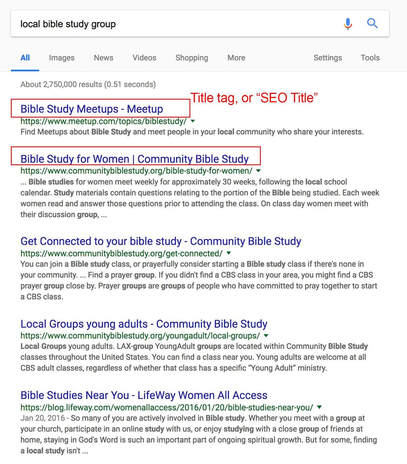
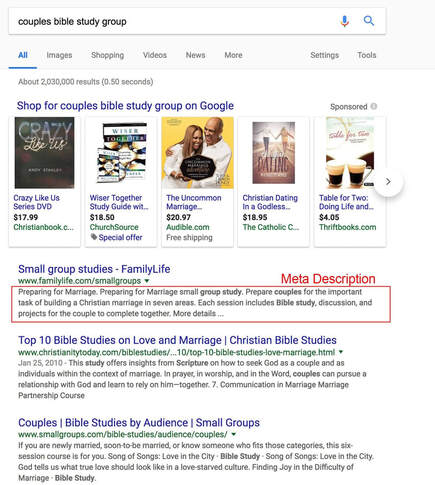
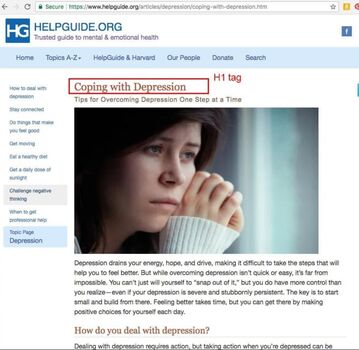



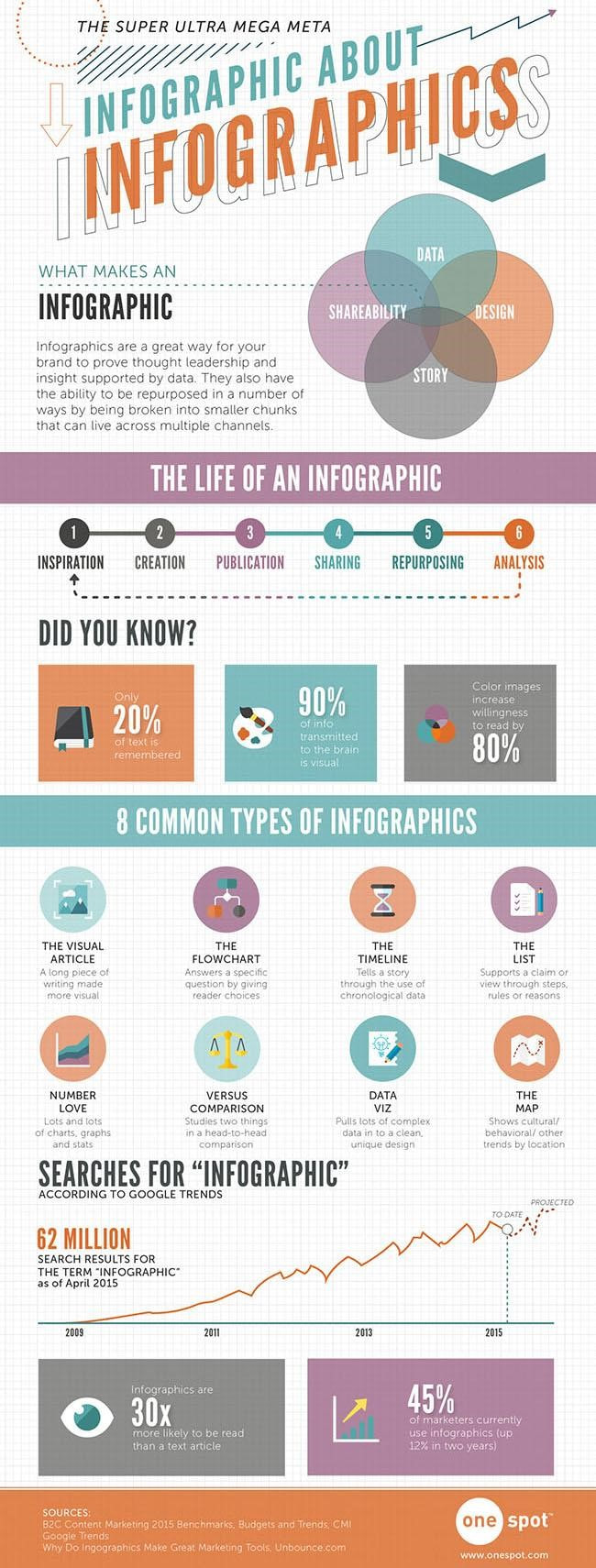

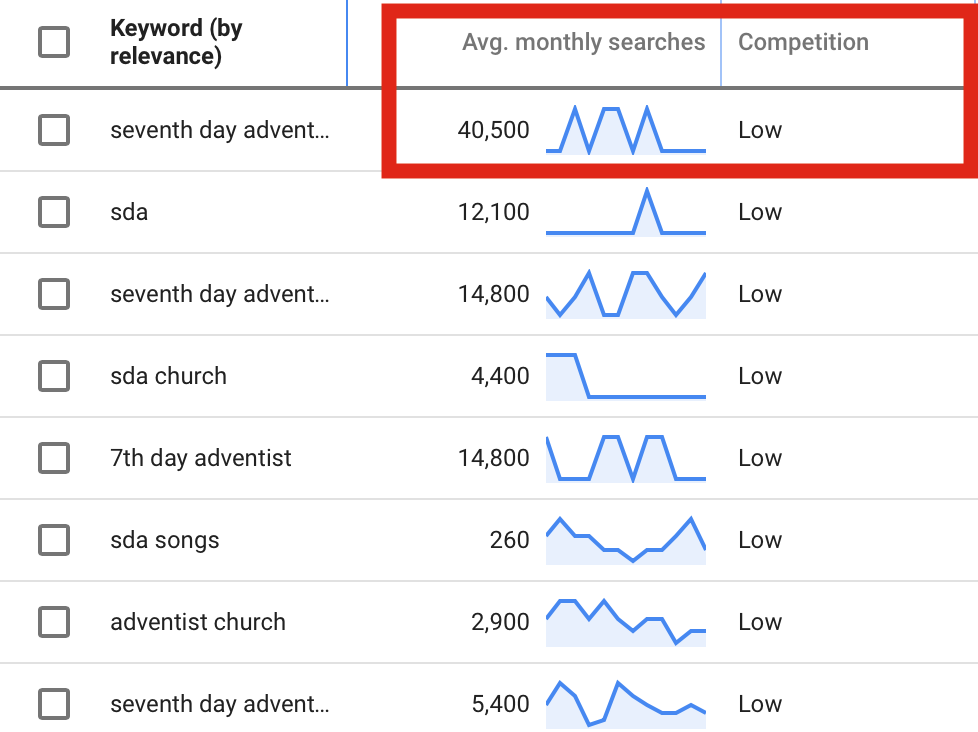



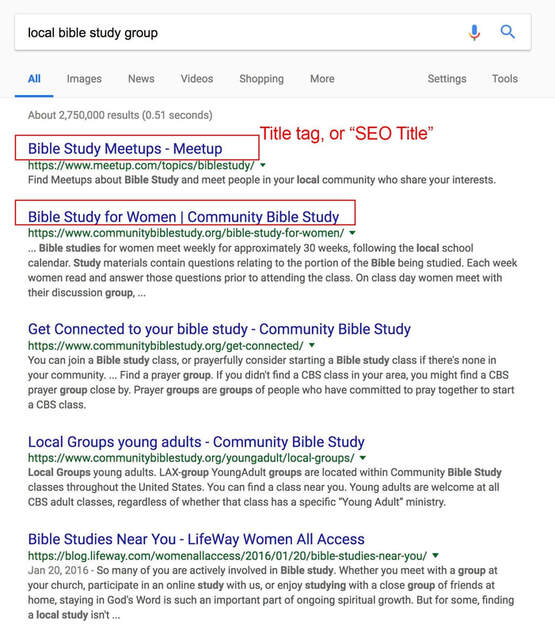
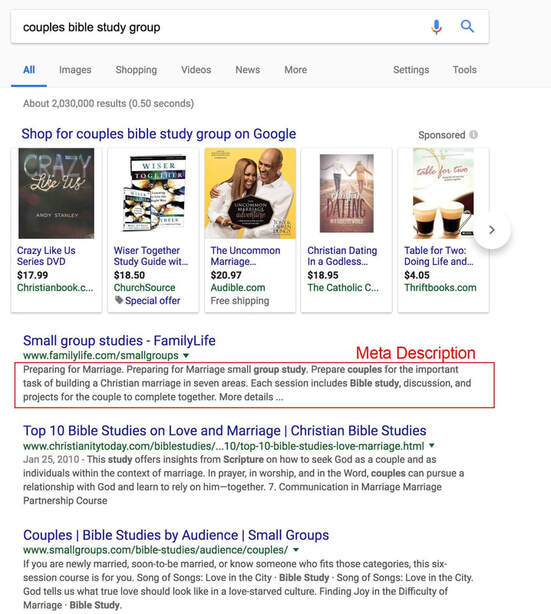
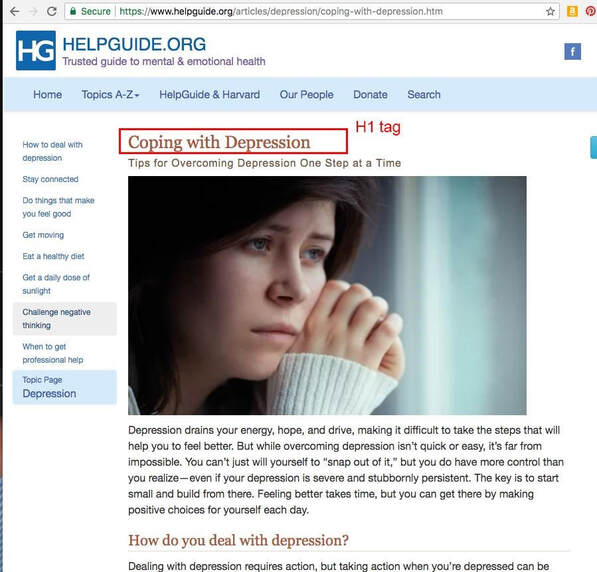



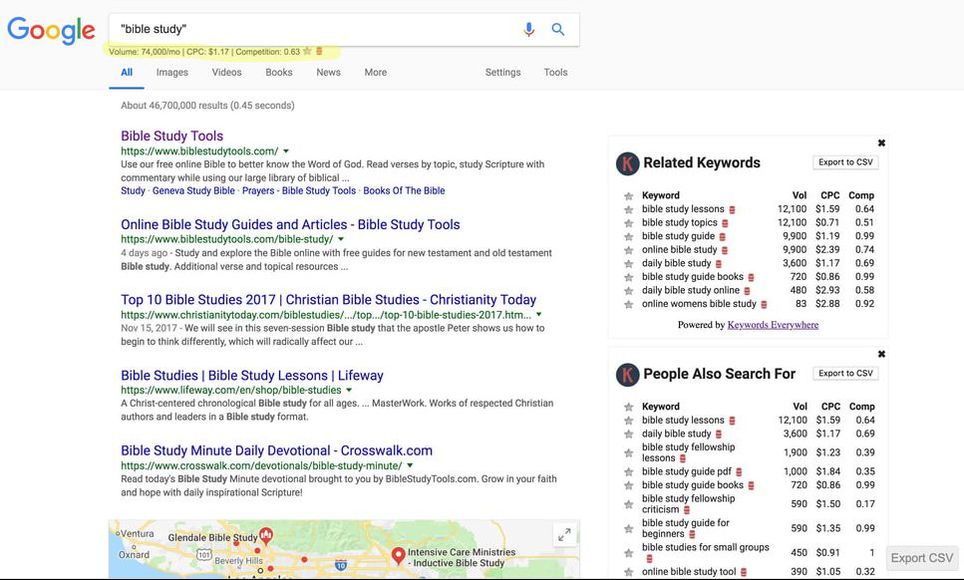

 RSS Feed
RSS Feed